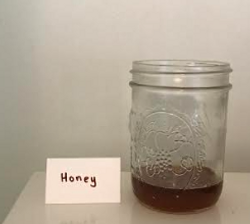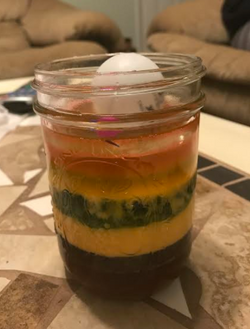
Things that Float:
The Density Tower
Materials for this Experiment:
-
Honey
-
Corn Syrup
-
Dish Soap
-
Milk
-
Water
-
Vegetable Oil
-
Rubbing Alcohol
-
Small cups/jars (one per liquid)
-
Optional: food coloring to dye the different layers of the density tower
How to make your own Density Tower:
-
Pour equal amounts of each liquid into separate cups (there will be 7 cups in all)
-
Set out the cups in the order of how you will pour the liquids into the larger container (honey, corn syrup, milk, dish soap, water, vegetable oil, and rubbing alcohol)
-
Start by pouring the honey out of the small cup and into the larger container. Pour very slowly, and make sure that the honey does not pour down the sides of your container! Repeat this process with the corn syrup. It's okay if it looks like the liquids are mixing a little bit as you layer them, they will even themselves out because they have different densities.
-
Next, very carefully add the milk and soap to the larger container. If you have one, use a funnel or a turkey baster to add these into the container (you want to add them vas slowly and carefully as possible!). If you add these to the container too quickly, you will not be able to clearly see each layer of your tower!
-
Now, add the water to the container by slowly dripping the water down the edge of the container. This layer should end up being above the dish soap layer. After adding the water in this fashion, add the vegetable oil and rubbing alcohol using the same strategy.
-
Allow all layers of the tower to settle. You should be able to see seven layers of liquids now!
-
Note: The original source of this experiment said that rubbing alcohol would rise above the vegetable oil. But, when I executed the experiment, the vegetable oil ended up floating above the rubbing alcohol! The density of rubbing alcohol (0.79 g/cm3) is in fact less than the density of vegetable oil (0.93 g/cm3), which led me to the understanding that because the oil is denser than the alcohol, and that the alcohol would float on top of the oil. This didn't happen, perhaps because I added dye to the oil, or possibly because of my own error! Either way, this experiment is certainly worth a shot!
Click here to visit the original source of this awesome density experiment:
Project Extension:
Believe it or not, if you carefully drop small objects into your density tower, they will settle into the layer of the tower that matches their density! The objects that you put in to the density tower will stay in the layer that is most similar to their own density (less dense objects will remain in the layers that contain less dense liquids, and more dense objects will move down to the layers that contain more dense objects!)
Possible Objects to add to your Density Tower:
-
A metal nut
-
A paper clip
-
A penny
-
A raisin
-
A ping pong ball
-
A cheerio
-
Some sequins
-
Get creative! You have countless options for what to add to your density tower!
 |  |  |  |
|---|---|---|---|
 |  |  |  |
So, how does this experiment work?
-
Density is essentially how much stuff (particles) of something is packed into a particular volume.
-
The density of something is calculated by dividing the mass of an object by its volume.
-
This equation tells us that the more "stuff" that is in a particular volume, the denser it becomes!In the opposite direction, the less "stuff" that is in a particular volume, the less dense an object is.
-
In doing the Cartesian Diver Project, we learned that less dense things "float" on top of more dense things, and sink if they are more dense than what they are contained inside of.
-
This is why less dense liquids, such as rubbing alcohol and vegetable oil float on top of more dense liquids like honey and corn syrup! And this is why the liquids settle into layers when they are poured into the jar!
Remember: The same principle that layers the liquids in the Density Tower is what allows the different objects that are placed into the jar to"float" at different levels within the container. For instance, a penny is more dense than all of the liquids in the jar, so it will sink to the very bottom of the container. Items will rest whatever layer is most similar to their density (above the layers that are more dense than they are and below the layers that are less dense than they are).
To continue our focus on density, I decided to make a density tower. A density tower is a container of liquids that remain in separate layers after they are poured into the same container. This is possible because each of the different liquids have different densities!
Here is my Density Tower Demo!



